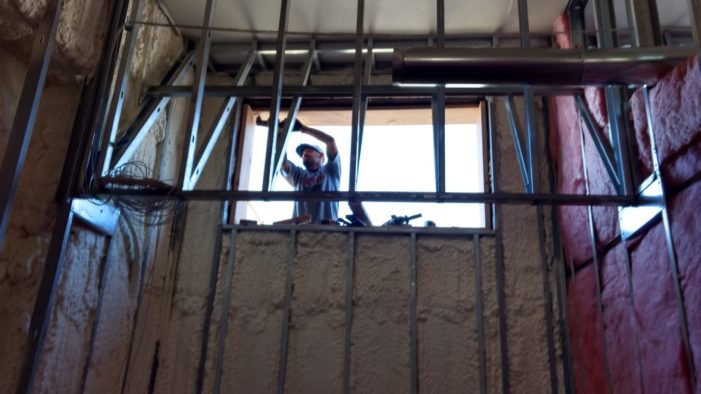As United Neighborhood Initiatives (UNI) completes renovation of a historic community building, I hear a familiar question: “Wouldn’t it have been better to tear down the old structure and build a new one?” Those wondering about the reason for UNI’s current work on the original 1923 portion of the Lawndale Center, in Detroit’s Springwells area, remind me of others who once asked why we renovated All Saints Neighborhood Center out of a 1921 chapel. This is a question that should be addressed frankly.

We deal with this kind of issue when deciding whether to keep fixing the old Taurus or scrap it and buy a Fusion. The Fusion is lighter, safer, handles and looks better, costs less to run, and is nicer to the planet. On the other hand, every time I see a 1968 Plymouth Sports Fury in the Dream Cruise, I kick myself for giving ours to a relative as we upgraded to a Buick Regal. Some old items mean more than just dollars and cents. They can stir powerful emotions of pride and nostalgia. It seems like a sin to discard works of craftsmanship that still inspire people.
When All Saints Neighborhood Center, our first Springwells project in 1998, emerged from layers of shabby, old siding and blossomed into an attractive link to the history of the neighborhood, I was amazed at the excitement it stirred. It became clear that even the simplest elements of beauty can lift spirits in surroundings that have become drab and worn.
We followed the Center project with a new park across the street. Since then, eight houses touching those boundaries have undergone significant renewal. Without a dollar of financial subsidy, four long-vacant units were reoccupied. Not a single structure was lost in the 2008 recession—an amazing record for a 1920s Detroit neighborhood of workers’ frame homes. Would this have happened if we had leveled the old St. Peter’s chapel for Lithuanian immigrants and built a flat-roofed neighborhood center in its place? I think not.
Good old buildings deserve to be renewed … (as) anchors for new generations of community-builders.
We are now creating something new out of something old on Lawndale. Originating as Zion Evangelical Church in 1923, the location became Westgate Masonic Temple in 1936 and finally closed in 1996 as a Moose Lodge.
Now, this building is about to house justice and legal aid services with young adult services also coming on line. Here, the Southwest Detroit Community Justice Center (SDCJC) will partner with 36th District Court to support the first community court in Michigan, making Detroit a stronger, safer, restorative justice community. The safety challenge to the neighborhood emerges in every survey and discussion. These concerns are rooted in reality: While local crime rates are below those of the larger city, Springwells would have to reduce violent crime by 73 percent and property crime by 45 percent to arrive at national averages (per 2010 state and FBI data). So this highly visible investment in safety and civil society will inspire continuing reinvestment and the long-term social stability that further reduces crime and supports community blossoming.

Long-term crime reduction will come from many sources such as increased prosperity, better education, and enhanced stability, due to improved bonding among residents. The Lawndale Center facility’s rebirth helps along each of these paths. Tonya Phillips, SDCJC executive director, believes the community court model that is reducing recidivism across the nation will benefit all of Southwest Detroit, becoming a model for other district courts across the city and the state.
The Lakeshore Legal Aid service will also help low-income families achieve stability in their attempts to be economically sufficient and conflict-free, long-term residents of the community. Residents are equally enthused about the potential of the building for improving youth services – 6,000 young people under age 18 live within a half mile! Other youth and young adult career development services are being designed to exploit the advantages of this site under the leadership of Christine Bell, executive director of UNI.

I also see the Lawndale Center as offering inspiration to cost-effective, ecologically responsible renovations of legacy structures. This project features a white, reflective, highly insulated roof to lower utility costs. LED lighting, Energy Star HVAC equipment, and spray foam insulation on the masonry walls seal the deal on lowering the carbon footprint. Our next phase will incorporate storm water mitigation solutions that lower drainage costs. Plants will help with both energy and drainage expenses while beautifying the site. Local art will adorn interior and exterior spaces.
Curiosity has been building. Passersby ask what is happening. Hearing about youth programs, legal aid and community justice services brings smiles, thumbs up and words of genuine appreciation.
The memories of people who once worshipped, danced or socialized here, who celebrated marriages or honored their deceased here, will now rise up, affirming respect for members of another generation. That is why a few good old buildings deserve to be renewed, anchors for new generations of community-builders.
Editor’s Note: The Lawndale Center is located at 2026 Lawndale near the intersection of Springwells and West Vernor Hwy. Sponsors of the current phase include the Detroit/HUD Community Development Block Grant Program, the Carls and Kresge Foundations, the Local Initiatives Support Corp., and Dr. Ghanem Ghannam, DDS.
Dennis Nordmoe is director of strategic development at Urban Neighborhood Initiatives (UNI). You may contact him at dnordmoe@unidetroit.org.


